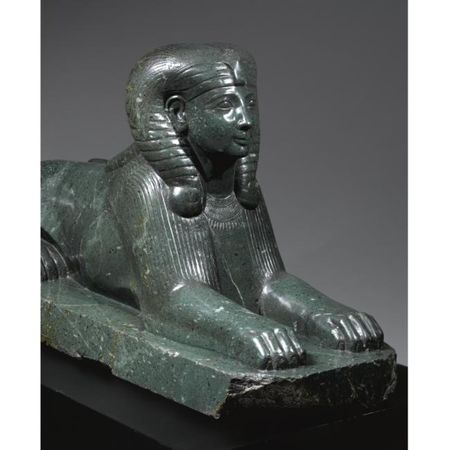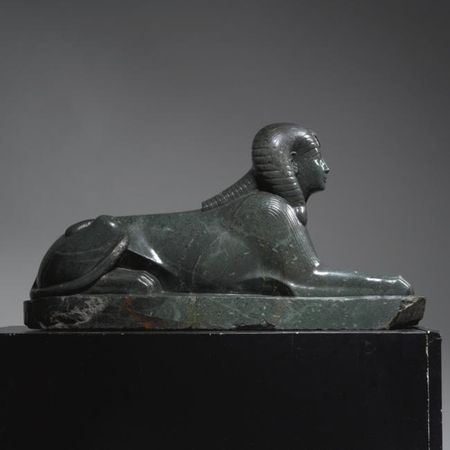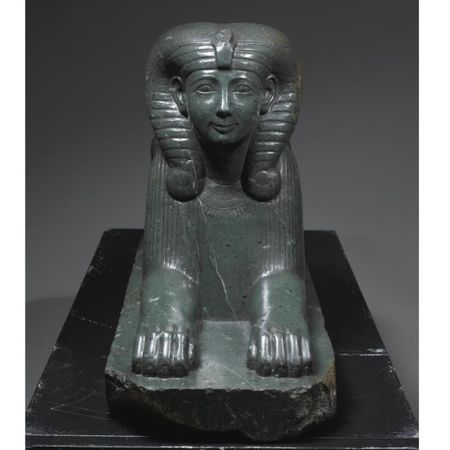A Green Porphyry Sphinx of an Egyptian Queen, Roman Imperial, circa 1st Century A.D, probably reign of Domitian, A.D. 81-96.
A Green Porphyry Sphinx of an Egyptian Queen, Roman Imperial, circa 1st Century A.D, probably reign of Domitian, A.D. 81-96. photo Sotheby'sphoto Sotheby's
couchant on a rectangular base rounded at the back, the tail curved around the right hindquarter, and wearing a broad beaded collar and centrally divided ribbed wig with voluted curls surmounted by the vulture headdress, her face with smiling mouth and long contoured eyebrows in relief; height 19 1/2 in. 49.5 cm.; length 37 1/2 in. 95.2 cm. Estimate 800,000—1,200,000 USD. Lot Sold 5,234,500 USD
PROVENANCE: Most likely from the sanctuary of the Egyptian gods, the Iseum Campense, on the Campus Martius in Rome
Hagop Kevorkian, New York, probably acquired before World War II
Kevorkian Foundation, New York (Sotheby's, London, November 13th, 1975, no. 180)
K.J. Hewett, London
James J. Freeman, London, 1979
LITERATURE AND REFERENCES: Anne Roullet, Egyptian and Egyptianizing Monuments of Imperial Rome, Leiden, 1972, p. 132, no. 277, fig. 289
Maarten J. Vermaseren, Margreet B. de Boer, and T.A. Eldridge, eds., Hommages à Maarten J. Vermaseren: recueil d'études offert par les auteurs de la série Études préliminaires aux religions orientales dans l'Empire romain à Maarten J. Vermaseren à l'occasion de son soixantième anniversaire le 7 avril 1978 (Etudes préliminaires aux religions orientales dans l'Empire romain, vol. 68), Leiden, 1977, p. 645
Giorgio Carredu, Museo Barracco di scultura antica. La collezione egizia, Rome, 1985, p. 19
Katja Lembke, Das Iseum Campense in Rom: Studie über den Isiskult unter Domitian (Archäologie und Geschichte, vol. 3), Heidelberg, 1994, p. 242, KAT. E 45, pl. 34,1
John Cherry, Mythical Beasts, London, 1995, pp. 120-121
Brian Anthony Curran, Ancient Egypt and Egyptian Antiquities in Italian Renaissance Art and Culture, doctoral dissertation, Princeton University, 1997, pp. 86-87, n. 62
Kim J. Hartswick, The Gardens of Sallust: A Changing Landscape, Austin, 2004, p. 190
Molly Swetnam-Burland, "Egyptian Objects, Roman Contexts: A Taste for Aegyptiaca in Italy," in Laurent Bricault, Miguel John Versluys, and Paul G.P. Meyboom, eds., Nile to Tiber: Egypt in the Roman World: Proceedings of the IIIrd International Conference on Isis Studies, Leiden, May 11-14, 2005, Leiden Brill, 2007, pp. 120-123, fig. 3 (p. 121)
LITERATURE AND REFERENCES: Anne Roullet, Egyptian and Egyptianizing Monuments of Imperial Rome, Leiden, 1972, p. 132, no. 277, fig. 289
Maarten J. Vermaseren, Margreet B. de Boer, and T.A. Eldridge, eds., Hommages à Maarten J. Vermaseren: recueil d'études offert par les auteurs de la série Études préliminaires aux religions orientales dans l'Empire romain à Maarten J. Vermaseren à l'occasion de son soixantième anniversaire le 7 avril 1978 (Etudes préliminaires aux religions orientales dans l'Empire romain, vol. 68), Leiden, 1977, p. 645
Giorgio Carredu, Museo Barracco di scultura antica. La collezione egizia, Rome, 1985, p. 19
Katja Lembke, Das Iseum Campense in Rom: Studie über den Isiskult unter Domitian (Archäologie und Geschichte, vol. 3), Heidelberg, 1994, p. 242, KAT. E 45, pl. 34,1
John Cherry, Mythical Beasts, London, 1995, pp. 120-121
Brian Anthony Curran, Ancient Egypt and Egyptian Antiquities in Italian Renaissance Art and Culture, doctoral dissertation, Princeton University, 1997, pp. 86-87, n. 62
Kim J. Hartswick, The Gardens of Sallust: A Changing Landscape, Austin, 2004, p. 190
Molly Swetnam-Burland, "Egyptian Objects, Roman Contexts: A Taste for Aegyptiaca in Italy," in Laurent Bricault, Miguel John Versluys, and Paul G.P. Meyboom, eds., Nile to Tiber: Egypt in the Roman World: Proceedings of the IIIrd International Conference on Isis Studies, Leiden, May 11-14, 2005, Leiden Brill, 2007, pp. 120-123, fig. 3 (p. 121)
NOTE: Discovery and Provenance
In 1856/58 , during excavations in the garden of a house belonging to a Giovanni Tranquilli, behind the apse of the church of Santa Maria Sopra Minerva in Rome, several Egyptian stone sculptures came to light. Similar archaeological discoveries had been made in the area since the 16th Century, and it was known that the nearby church was built on the ruins of a large temple to Isis and Serapis, the Iseum Campense, restored to its full glory and expanded by the Emperor Domitian in the last decades of the 1st Century A.D. The objects found in 1856/58 were described as: a pink granite column carved in relief with an Isiac procession, a granite headless figure of a cow, a kneeling stone statue of a man, or naophoros, a Romano-Egyptian stone stele, a granite sphinx without hieroglyphs, and another granite sphinx inscribed with hieroglyphs on the chest (Ch. Ampere and G. Henzen, "Monumenti egizi, ritrovati in Roma," Bullettino dell'Instituto di corrispondenza archeologica, 1858, pp. 46-47). The Florentine collector of Greek and Roman antiquities Giovanni Barracco took interest in the discovery, convinced the Italian State to purchase the cow and the naophoros for the Florence Museum, and acquired for his own collection the inscribed sphinx, which he published extensively himself as a representation of Queen Hatshepsut; it is now in the Museo Barracco in Rome (Roullet 1972, p. 133, no. 278, fig. 290; Carredu 1985, pp. 18-19, no. 17). Rodolfo Lanciani later gave a more specific description of the uninscribed sphinx, which had remained in the possession of Sig. Tranquilli: it was a Ptolemaic or Roman work made of red granite, 1.35 m. long and .68 m. high (Bullettino della Commissione archeologica comunale di RomaCR, 1883, p. 49; Topografia di Roma antica, Rome, 1880, p. 5; Pagan and Christian Rome, New York, 1893, p. 124); it is now in the Capitoline Museum (S. Bosticco, Musei capit
Sotheby's. Antiquities from the Collection of the Late Clarence Day. 07 Dec 10. New York www.sothebys.com

/https%3A%2F%2Fprofilepics.canalblog.com%2Fprofilepics%2F1%2F0%2F100183.jpg)
/https%3A%2F%2Fstorage.canalblog.com%2F03%2F02%2F119589%2F96711876_o.jpg)
/https%3A%2F%2Fstorage.canalblog.com%2F11%2F31%2F119589%2F94773502_o.jpg)
/https%3A%2F%2Fstorage.canalblog.com%2F20%2F83%2F119589%2F94772815_o.jpg)
/https%3A%2F%2Fstorage.canalblog.com%2F26%2F72%2F119589%2F75604929_o.jpg)
/https%3A%2F%2Fstorage.canalblog.com%2F59%2F60%2F119589%2F26458628_o.jpg)





/http%3A%2F%2Fstorage.canalblog.com%2F51%2F38%2F119589%2F120941856_o.jpg)
/http%3A%2F%2Fstorage.canalblog.com%2F40%2F89%2F119589%2F118054171_o.jpg)
/http%3A%2F%2Fstorage.canalblog.com%2F40%2F41%2F119589%2F117699856_o.jpg)
/http%3A%2F%2Fstorage.canalblog.com%2F92%2F93%2F119589%2F110780384_o.jpg)